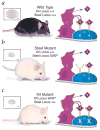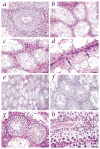Transplantation of male germ line stem cells restores fertility in infertile mice
- PMID: 10613820
- PMCID: PMC4879876
- DOI: 10.1038/71496
Transplantation of male germ line stem cells restores fertility in infertile mice
Abstract
Azoospermia or oligozoospermia due to disruption of spermatogenesis are common causes of human male infertility. We used the technique of spermatogonial transplantation in two infertile mouse strains, Steel (Sl) and dominant white spotting (W), to determine if stem cells from an infertile male were capable of generating spermatogenesis. Transplantation of germ cells from infertile Sl/Sld mutant male mice to infertile W/Wv or Wv/W54 mutant male mice restored fertility to the recipient mice. Thus, transplantation of spermatogonial stem cells from an infertile donor to a permissive testicular environment can restore fertility and result in progeny with the genetic makeup of the infertile donor male.
Figures



Comment in
-
Germ cell transplantation--a fertile field.Nat Med. 2000 Jan;6(1):16-7. doi: 10.1038/71469. Nat Med. 2000. PMID: 10613812 No abstract available.
References
-
- Greenberg SH, Lipshultz LI, Wein AJ. Experience with 425 subfertile male patients. J Urol. 1978;119:507–510. - PubMed
-
- Sigman M, Lipshulz LI, Howard SS. In: Infertility in the Male. 3. Lipshulz LI, Howard SS, editors. Mosby; St. Louis: 1997. pp. 173–193.
-
- Russell LD, Ettlin RA, SinhaHikim AP, Clegg ED. Histological and Histopathological Evaluation of the Testis. Cache River, Clearwater, Florida: 1990. pp. 1–40.
-
- Silvers WK. The Coat Colors of Mice. Springer Verlag; New York: 1979. pp. 206–223.
Publication types
MeSH terms
Substances
Grants and funding
LinkOut - more resources
Full Text Sources
Other Literature Sources
Medical
Molecular Biology Databases

